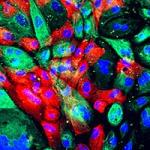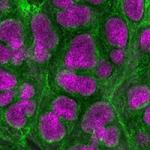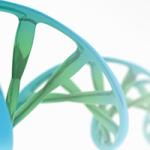
Alan Robert Kimmel, Ph.D.
Senior Investigator
Molecular Mechanisms of Development Section, Laboratory of Cellular & Developmental Biology
NIDDK
Research Topics
Our laboratory group studies signaling cascades essential for eukaryotic growth and development, using molecular, genetic, cellular, and biochemical techniques, and the model eukaryote Dictyostelium, which grow as individual phagocytic cells in enriched media, but develop multicellularly upon nutrient depletion. We have defined cell autonomous and non-autonomous signal transduction pathways that drive transitional decisions to promote growth and/or regulate development. We probe a variety of signaling pathways which are shared in complex systems to better understand mechanisms and circuits for focus on human diseases. In certain instances, we extend studies to mammalian models.
Aspects of innate immunity derive from characteristics inherent to phagocytes, including chemotaxis toward and engulfment of unicellular organisms or cell debris. Ligand chemotaxis has been biochemically investigated using mammalian and model systems, but precision of chemotaxis towards ligands being actively secreted by live bacteria is not well studied, nor has there been systematic analyses of interrelationships between chemotaxis and phagocytosis. The genetic/molecular model Dictyostelium and mammalian phagocytes share mechanistic pathways for chemotaxis and phagocytosis; Dictyostelium chemotax toward bacteria and phagocytose them as food sources. Using Dictyostelium as a model, we developed a system that is able to quantify chemotaxis to very high sensitivity. Here, Dictyostelium can detect various chemoattractants at concentrations
<1 nM. Given this exceedingly sensitive signal response, we were able to demonstrate directed migration of Dictyostelium toward live gram positive and gram negative bacteria, in a highly quantifiable manner, and dependent upon bacterially-secreted chemoattractants. Additionally, we have developed a real-time, quantitative assay for phagocytosis of live gram positive and gram negative bacteria. To extend the analyses of endocytic functions, we further modified the system to quantify cellular uptake via macropinocytosis of smaller (<100 kDa) molecules. Additive/competitive assays indicate that intracellular signaling-networks for multiple ligands utilize independent upstream adaptive mechanisms, but common downstream targets, thus amplifying detection at low signal propagation, but strengthening discrimination of multiple inputs. Finally, analyses of signaling-networks for chemotaxis and phagocytosis indicate that chemoattractant receptor-signaling is not essential for bacterial phagocytosis. These various approaches provide novel means to dissect potential for identification of novel chemoattractants and mechanistic factors that are essential for chemotaxis, phagocytosis, and/or macropinocytosis and for more detailed understanding in host-pathogen interactive defenses. The recognition and killing of infectious bacteria by macrophage and other phagocytic cells is a paramount defense strategy within the innate immune response. Multiple compounds are released by bacteria, and different phagocytic cells express specific chemoattractant receptors with distinct binding specificities; activation of these receptors directs a complex series of intracellular signaling pathways that guide directed cell migration toward a bacterial source. However, many bacterial chemoattractants are structurally related to molecules that are synthesized by and, thus, intrinsic to phagocytic cells. If these molecules were released from cells and also recognized by a chemoattractant receptor, they could create a confounding signal that would interfere with directional sensing of the bona fide bacterially-released chemoattractant gradient; this would be distinct from an auto-immune response. We investigated approaches that could suppress such interfering signals, without disrupting bacterial sensing and targeting of infectious bacteria. As are macrophage, Dictyostelium are professional phagocytes with highly sensitive chemoattraction toward gram positive and gram negative bacteria. Dictyostelium recognize several bacterially-secreted compounds. The Dictyostelium chemoattractant G protein coupled receptor Far1 is activated by bacterially-secreted folate. Folate is part of the family of pterin/pteridine molecules and is essential for Dictyostelium (and mammalian) cell growth. Dictyostelium, in addition, synthesize several structurally related pteridine molecules. We present evidence for different mechanisms that allow Dictyostelium to distinguish bacterial signals for chemotaxis from endogenous compounds. Through structure/function studies, we show that Far1 activation affinity is highly sensitive to very minor structural modifications relative to folate and shows strong preference to secreted bacterial products than to structurally similar but distinct endogenous molecules. Dictyostelium secrete a deaminase that will modify compounds to render them inactive. Cells can very rapidly inactivate close proximity environmental signals, but are still able to recognize an active incoming signal, before it becomes deaminated and inactivated; this mechanism would also reinforce the strength of the exogenous chemoattractant gradient for enhanced directional sensing. Surprisingly, anti-folates (e.g. methotrexate) are resistant to this inactivation. In addition, we show that the secretion of endogenous compounds are minimized during times of active chemotaxis to bacteria.
This laboratory also investigates molecular processes required for establishing a terminally differentiated organism from a homogeneous population of totipotent cells and is defining signal transduction pathways that specify developmental cell fates and pattern formation. By characterizing receptor-mediated cascades and nuclear targets, our research serves to identify mechanisms that are basic to multicellular differentiation. Organizing the embryonic body plan is a major requisite governing early metazoan development, with morphogen signaling central to establishing and specifying cell fates. Developmental aggregation in Dictyostelium is lost at low cell density, but aggregation at non-permissive cell densities is rescued with secreted factor DPF1. Secreted DPF1 is synthesized as a larger precursor, single-pass transmembrane protein that is released by proteolytic cleavage and ectodomain shedding, leaving a ~10 kDa transmembrane (TM) fragment. The TM/cytoplasmic domain of DPF1 possesses independent, cell autonomous activity for cell-substratum adhesion and cellular growth. We have created vectors that solely express the secreted or TM/cytoplasmic forms to understand the different functions. We have also identified a new gene DPF2, which is closely linked to DPF1, that encodes a sequence related protein with similar processing and ectodomain shedding properties. Ectodomain cleavage of both DPF1 and DPF2 is largely dependent upon calcium and calcium-dependent proteases (calpains). Secreted p150 kDa fragments of DPF1 and DPF2 have been purified in mg quantities and are being analyzed by MS/MS to map the specific cleavage sequences. We hypothesize there is pathway interaction between DPF1 and DPF2 and are testing this directly in mixing experiments with differentially epitope-tagged versions of DPF1 and DPF2. We have shown homo- and hetero-dimerization of the transmembrane domains of both DPF1 and DPF2. Post-transcriptional processes mediated by mRNA binding proteins represent important control points in gene expression. We have identified a tandem zinc finger protein TTP in Dictyostelium that promotes mRNA decay, likely through interaction with CCR4-NOT protein complexes. Six mRNA transcripts are consistently upregulated in null and point mutants compared to WT, and the 3'-untranslated regions (3'-UTRs) of all six contain multiple, overlapping UUAUUUAUU motifs; one 3'-UTR conferred TTP post-transcriptional stability regulation to a heterologous mRNA that was abrogated by mRNA mutations in the core UA-rich motifs. Expression of the Dictyostelium protein in mammalian cells promotes mRNA decay of mammalian transcripts that contain these motifs; likewise expression of a human protein in Dictyostelium cells promotes mRNA decay of Dictyostelium transcripts that contain these motifs, despite evolutionary divergence of nearly a billion years. Function requires more than a single motif. Dependence may also require open structures within the 3’UTRs. Interactions with mRNAs and proteins are being followed with IP of functionally active epitope tagged TTP.
We also maintain active collaborations to understand molecular mechanisms required for lipogenic and lipolytic action in mammalian cells. Excessive cellular lipid storage can be a risk factor for metabolic disorders, including insulin resistance, cardiovascular disease, and hepatic steatosis. Intracellular lipid droplets are unique organelles that store metabolic precursors of cellular energy, membrane biosynthesis, steroid hormone synthesis, and signaling. We first discovered the Perilipins (PLINs) as a 5 member multi-protein family that targets lipid droplet surfaces and regulates lipid storage and hydrolysis in mammalian cells. Each Plin member has unique lipid association properties, cell expression patterns and cell-specific functions.
Excessive cellular lipid storage can be a risk factor for metabolic disorders, including insulin resistance, cardiovascular disease, and hepatic steatosis. Intracellular lipid droplets are unique organelles that store metabolic precursors of cellular energy, membrane biosynthesis, steroid hormone synthesis, and signaling. The perilipins are a multi-protein family that targets lipid droplet surfaces and regulates lipid storage and hydrolysis. Plin2 binds hepatic LDs with expression levels that correlate with TAG content. We investigated the role of Plin2 in hepatic LD storage in fed and fasted plin2+/+ and plin2-/- mice. Chow-fed plin2-/- mice had comparable body weights, metabolic phenotype, glucose tolerance, and circulating TAG and total cholesterol levels to WT. Overnight fasting stimulates the degradation of stored adipose TAGs, with release of non-esterified fatty acids for circulation. Fasted plin2-/- mice showed substantially reduced accumulation of hepatic TAG compared to fasted WT. RNAseq revealed minor differences in hepatic gene expression between fed plin2+/+ and plin2-/- mice but marked differences in expression between fasted plin2+/+ and plin2-/- mice. Plin2 regulates hepatic lipid droplet size and accumulation of neutral lipid species in the fasted state. Recent studies describe transcriptome changes associated with hepatosteatosis, but it has been difficult to separate the effects on hepatic gene expression of fatty liver from that of obesity. We studied a plin2-/- mouse model, under conditions that are highly protective to hepatostaetosis, but not diet-induced obesity. We determined the mechanistic functions that protect plin2-/- livers from lipid accumulation and using RNAseq, compared hepatic transcriptomes of chow-fed or high-fat diet plin2+/+ and plin2-/- mice. We show that the Plin2 genotype, and accordingly hepatosteatosis, has a more limited impact on hepatic gene expression than does diet-induced obesity.
Biography
- American Cancer Society Senior Fellowship, University of California, San Diego, 1979-1981
- Visiting Scientist, German Cancer Research Center, 1979
- American Cancer Society Fellowship, University of California, San Diego, 1977-1979
- Ph.D., University of Rochester, 1977
Selected Publications
- Jaiswal P, Meena NP, Chang FS, Liao XH, Kim L, Kimmel AR. An integrated, cross-regulation pathway model involving activating/adaptive and feed-forward/feed-back loops for directed oscillatory cAMP signal-relay/response during the development of Dictyostelium. Front Cell Dev Biol. 2023;11:1263316.
- Meena NP, Kimmel AR. Chemotactic network responses to live bacteria show independence of phagocytosis from chemoreceptor sensing. Elife. 2017;6.
- Kimmel AR, Sztalryd C. The Perilipins: Major Cytosolic Lipid Droplet-Associated Proteins and Their Roles in Cellular Lipid Storage, Mobilization, and Systemic Homeostasis. Annu Rev Nutr. 2016;36:471-509.
- Tansey JT, Sztalryd C, Gruia-Gray J, Roush DL, Zee JV, Gavrilova O, Reitman ML, Deng CX, Li C, Kimmel AR, Londos C. Perilipin ablation results in a lean mouse with aberrant adipocyte lipolysis, enhanced leptin production, and resistance to diet-induced obesity. Proc Natl Acad Sci U S A. 2001;98(11):6494-9.
- Kim L, Harwood A, Kimmel AR. Receptor-dependent and tyrosine phosphatase-mediated inhibition of GSK3 regulates cell fate choice. Dev Cell. 2002;3(4):523-32.
Related Scientific Focus Areas




Molecular Biology and Biochemistry
View additional Principal Investigators in Molecular Biology and Biochemistry
This page was last updated on Thursday, August 7, 2025